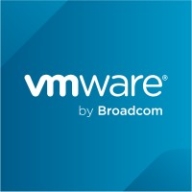

IBM PowerVM and VMware ESXi are two primary players in the virtualization market. While both platforms excel in different areas, VMware ESXi's comprehensive integration capabilities and lightweight, user-friendly setup give it a slight edge in diverse deployment scenarios.
Features: IBM PowerVM stands out with flexible hardware resource management, strong security for database workloads, and effective handling of complex Oracle licensing thanks to Live Partition Mobility and shared processor pools. Meanwhile, VMware ESXi offers high availability, disaster recovery, and vMotion, coupled with extensive third-party application support and a simplified installation process.
Room for Improvement: IBM PowerVM could improve with expanded OS compatibility and lower pricing, alongside better interface elements and cloud integration. VMware ESXi can be challenging to set up, and pricing has been a concern post-Broadcom acquisition, with calls for better licensing transparency and support response.
Ease of Deployment and Customer Service: IBM PowerVM is suited for on-premises deployments, notable for strong technical support and timely resolutions. VMware ESXi offers hybrid cloud deployment options but has mixed feedback on customer service, with some areas needing improvements.
Pricing and ROI: IBM PowerVM is perceived as expensive but justified for long-term performance, especially for Oracle workloads with inclusive licensing. VMware ESXi's pricing is complex and has increased after Broadcom's acquisition, impacting perceived value, though both solutions offer substantial ROI depending on their specific use cases.
The return on investment is substantial, though other platforms may offer a better ROI, primarily due to lower costs involved in setup and maintenance.
If calculated over a five-year period, IBM PowerVM is 30 to 40% more cost-effective than physical servers despite initial costs seeming high.
IBM provides strong support.
IBM offers excellent customer support.
IBM's technical support is outstanding, with seamless global coordination and prompt resolutions.
I rate the technical support from VMware as nine or ten out of ten.
In the last three or four years, we did not require any support from VMware engineers, indicating its high reliability.
Customer service and support are good; they are reachable, and at times remote support suffices.
An IBM server can handle up to sixty-four terabytes of RAM.
The product is scalable due to PowerVM's virtualization features, such as shared processor functionality and partition mobility.
I think IBM PowerVM uses a 'pay as you grow' model, allowing customers to scale their resources as needed.
The solution is scalable, allowing us to scale up or down regardless of infrastructure size.
vCenter Server can manage up to 1,000 ESXi servers within a single UI interface, allowing extensive deployment and management capabilities.
My customers are highly satisfied with its scalability.
The stability of IBM PowerVM is exceptional, as industry reports have named IBM Power and Z as the most stable platforms globally for 15 consecutive years.
Our clients in India using Power Servers have been running their servers for the last four to five years without any reboot.
The product operates reliably, and following IBM’s best practices ensures robust stability.
ESXi is stable, and our business operations depend on it year after year.
Stability rates a perfect 10.
We have a strong relationship with IBM, which aids decision-making in transitioning clients from mainframe to other platforms.
PowerVM should integrate some capabilities of VMware vCenter to improve its management features.
From a product perspective, I would like to see faster certification of open-source products on IBM Power Systems.
Providing a mobile application for remote access to ESXi servers would be beneficial.
It's not cost-effective for small users and creates a gap for alternatives, while favoring larger clients.
The cost of VMware ESXi is very high, especially after the acquisition by Broadcom, which led to price increases.
Pricing is a concern in Argentina due to the higher cost of mainframe solutions.
PowerVM itself is free with the purchase of an IBM server.
While initially costly, the ROI over five years proves IBM PowerVM is cost-effective, resulting in a 30 to 40% reduction in costs compared to a physical setup.
The product is very cost-effective, though not fixed, as pricing tends to fluctuate over time.
The solution is moderately priced, not exactly cheap yet not overly expensive either.
The pricing is expensive, with the cost for customers ranging from $10,000 to $20,000 yearly.
Features like partition mobility enhance the machine's capabilities, making it an ideal tool for virtual environments with reliability, availability, and serviceability.
PowerVM excels in efficiently managing all systems and environments, including development, UI, and production.
It supports specific workloads, like Oracle and SAP HANA, much better due to its shared processor pool feature which reduces licensing costs.
Its capability to move virtual machines to physical machines is very efficient for our live environment.
As a level one or bare metal hypervisor, its unmatched scalability depends on underlying hardware, capable of managing large numbers of physical servers with one management platform.
vMotion is a daily used technology that allows us to have machines distributed across different sites while maintaining redundancy between the sites.
| Product | Market Share (%) |
|---|---|
| VMware ESXi | 1.7% |
| IBM PowerVM | 1.3% |
| Other | 97.0% |


| Company Size | Count |
|---|---|
| Small Business | 13 |
| Midsize Enterprise | 5 |
| Large Enterprise | 20 |
| Company Size | Count |
|---|---|
| Small Business | 12 |
| Midsize Enterprise | 5 |
| Large Enterprise | 14 |
VMware ESXi serves as a hypervisor enabling virtualization by transforming physical servers into virtual infrastructures, supporting efficient server management, development, and production environments.
Organizations utilize VMware ESXi for its high availability and ability to host diverse workloads effectively. Known for stability and maturity, it efficiently handles server, networking, and storage demands, with integral features like vMotion and memory compression. ESXi integrates well with data center operations, allowing seamless resource allocation and virtual machine migration. Despite impressive capabilities, users encounter challenges with setup complexity, licensing costs, and technical support delays, leading some to explore different solutions.
What are the main features of VMware ESXi?
What benefits and ROI do organizations see with VMware ESXi?
Industries deploying VMware ESXi benefit in sectors requiring robust IT infrastructure, including finance, healthcare, and education. Its capability to support high availability and diverse workloads proves essential for critical applications, enhancing productivity and agility in dynamic environments.
We monitor all Server Virtualization Software reviews to prevent fraudulent reviews and keep review quality high. We do not post reviews by company employees or direct competitors. We validate each review for authenticity via cross-reference with LinkedIn, and personal follow-up with the reviewer when necessary.